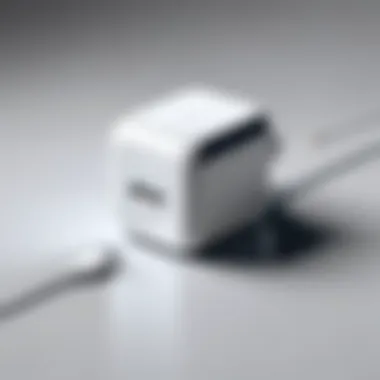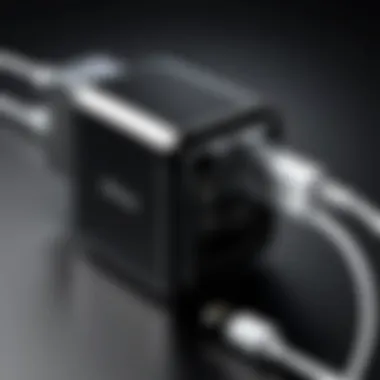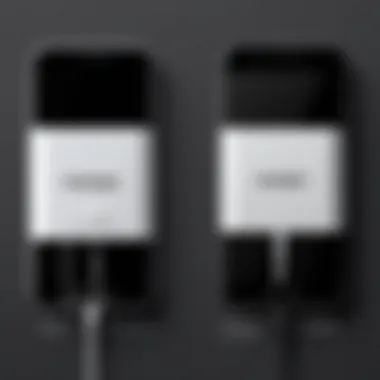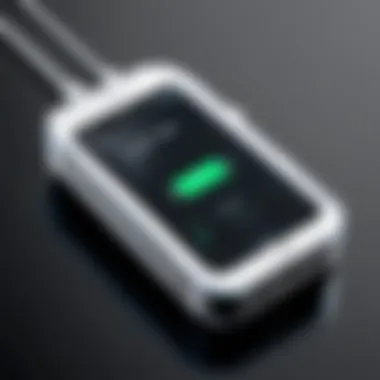The Official iPhone Charger: Specifications & Insights


Intro
The iPhone charger is an essential accessory that plays a critical role in the overall user experience. Its importance is often understated as many users take it for granted. This article aims to dive deep into the details surrounding the official iPhone charger, elaborating on its specifications, compatibility, and performance. The nuances of using third-party chargers will also be explored to illuminate the potential risks involved. This discussion is of great relevance in today’s tech landscape, where charging technology continually evolves and shapes how we use our devices.
Understanding the significance of officially sanctioned accessories can help users make informed decisions that protect their devices and extend their functionality. This exploration is particularly aimed at IT professionals and tech enthusiasts who require a nuanced understanding of how charging technology impacts device longevity and performance.
Overview of Hardware/Software
Intro to the product and its key features
The official iPhone charger, often referred to as the Apple USB Power Adapter, is crafted to meet specific electrical and technical standards. It is designed to work seamlessly with various iPhone models, ensuring efficient charging without compromising device integrity. Key features include compatibility with Lightning connectors, optimized charging speeds, and built-in safety measures that protect both the charger and the device.
Specifications and technical details
The latest iteration of the official iPhone charger typically comes with a power output of either 20W or 30W, depending on the model. It features:
- USB-C connectivity for fast charging capabilities.
- Compact design for portability and ease of use.
- Thermal regulation to prevent overheating.
- Compatibility with a range of devices, including iPads and AirPods, enhancing its utility.
When combined with a compatible cable, it can significantly reduce charging time compared to older models, particularly when used with iPhone 12 and later versions.
Pricing and availability
The Apple USB Power Adapter is available for purchase directly from Apple's website and authorized retailers. The price is generally in line with other high-quality charging products, reflecting the brand's commitment to quality and safety. Prices may vary slightly depending on location and promotional deals, but consumers can expect a competitive price.
Comparison to previous versions/models
In comparison to previous models, the latest official iPhone charger has adapted to technological advancements. Earlier versions provided only 5W or 12W charging, which is now seen as slow relative to the current standards. The transition to a higher wattage charging option not only reflects consumer demand for speed but also the improvements in battery technology that allow for faster charging without damaging the battery life.
Pros and Cons
Highlighting the strengths and weaknesses of the product
Pros:
- Efficient charging with minimal heat generation.
- High compatibility across multiple Apple products.
- Reliable safety features that prevent overload.
- Compact size makes it easy to carry.
Cons:
- Higher price point compared to some third-party options.
- Limited to USB-C connectors, requiring adapters for older cables.
User feedback and reviews
User feedback is generally positive, with many praising the efficiency and reliability of the charger. Some users do express minor frustrations regarding the pricing compared to non-official alternatives, though they often acknowledge the value in using an official product.
Performance and User Experience
Performance testing results
Real-world performance testing indicates that the official iPhone charger can provide up to 50% charge in approximately 30 minutes when paired with compatible devices. This rapid charging capability is particularly beneficial for users with hectic lifestyles who cannot afford long downtime for charging.
User interface and ease of use
The simplicity of plugging the Lightning cable into the charger makes it user-friendly. There is little to no setup involved, making it accessible even to less tech-savvy users.
Real-world usage scenarios
In daily life, users report that having the official charger at home and in their workplace enables them to maintain their devices in fully charged condition throughout the day. The faster charging time directly impacts productivity, empowering users to stay connected longer without interruptions.
Efficiency and productivity impact


The efficiency of the official iPhone charger directly correlates to user productivity. Less time spent charging means more time spent utilizing the device, whether for work-related tasks, entertainment, or communication.
Innovation and Trends
Industry trends related to the product category
The tech industry is seeing a shift towards fast charging technologies. Many manufacturers are optimizing devices for higher efficiency and shorter charging times. This trend aligns with Apple’s latest advancements in the official iPhone charger.
Innovative features and functionalities
Recent features, such as dynamic fast charging, allow devices to adjust the voltage level as per the battery's charge state. This innovative approach minimizes energy waste and prolongs battery life, showcasing Apple's focus on sustainability.
Potential impact on the IT industry
As charging technology evolves, its implications extend beyond individual users to the entire IT sector. Professionals must assess the importance of reliable accessories as they design and implement strategies for device management and support, particularly in enterprise environments.
Recommendations and Finale
Overall verdict and recommendations
Target audience suitability
This article is tailored for IT professionals, tech enthusiasts, and anyone interested in understanding the nuances of charging technology. It emphasizes the importance of utilizing official accessories in a rapidly advancing tech ecosystem.
Final thoughts and future prospects
As charging technologies continue to progress, staying informed will be critical for users and professionals alike. The future of charging may involve even further advancements in rapid charging and sustainable practices, reinforcing the need for reliable accessories like the official iPhone charger.
Prolusion to the Official iPhone Charger
The official iPhone charger plays a central role in how users experience their devices. It is more than just a power source; it is a vital component that influences device longevity, performance, and overall usability. Understanding the official charging system, its specifications, and its design is crucial, particularly for tech enthusiasts and IT professionals who want to get the most out of their gadgets.
The benefits of using the official charger include optimized charging speeds and safety features that protect both the battery and the device itself. Apple designs its chargers to work specifically with its devices, allowing for seamless integration. This ensures that the user receives the best possible experience without the risk associated with third-party alternatives.
Moreover, there are considerations that extend beyond basic functionality. The evolution of charging technology reflects advancements in power management, which are essential for modern devices. Familiarity with these aspects provides insights into how technology continues to evolve in response to user needs.
History and Evolution of iPhone Charging Technology
The history of charging technology for the iPhone is marked by continuous innovation aimed at enhancing user experience. With the launch of the iPhone in 2007, Apple initially utilized the 30-pin connector. This design was practical but limited in terms of efficiency and convenience. The transition to the Lightning connector in 2012 was revolutionary. It offered a smaller design, allowed for reversible connection, and improved data transfer speeds.
As charging needs evolved, so did the technology behind it. The introduction of fast charging capabilities with models like the iPhone 8 marks a significant advancement, enabling users to charge their devices quicker. This technological progression reflects a broader trend towards efficiency, aimed at coping with the increasing power demands of modern applications and mobile usage.
Design Aspects of the Official Charger
The design of the official iPhone charger is both functional and aesthetic. Apple’s commitment to minimalism and user-friendly design is evident in every aspect, from the sleek appearance to the practical design elements. The charger cable is often sturdier than many third-party options, which tend to fray or break more easily. This is due to careful material selection that balances flexibility and durability.
Additionally, Apple incorporates safety features into its charging accessories. The design includes overcurrent protection, which helps prevent damage during the charging process. Understanding these design aspects can help users appreciate the value of the official charger, not just as a tool for charging but as an investment in the longevity and performance of their devices.
"Using the official iPhone charger is crucial for optimal performance and battery longevity."
This knowledge serves to inform users about why sticking to official products is often a better decision when it comes to maintaining the integrity of their devices.
Specifications of the Official iPhone Charger
Understanding the specifications of the official iPhone charger is essential for anyone looking to maximize their device's performance and lifespan. The charger is not merely a conduit for electric current; it embodies intricate engineering designed to meet Apple's high standards. Key specifications dictate how well the charger operates, and why it is deemed superior to many third-party alternatives. Let's break down some of these critical features and their implications for the user experience.
Charging Speed and Efficiency
Charging speed and efficiency are pivotal in assessing the merit of the official charger. Apple’s chargers are designed to deliver efficient power to devices, minimizing charging times while preserving battery health. The charging speed primarily hinges on the power output of the charger, measured in Watts.
For example, the 20W USB-C charger allows for fast charging compatible with the newer iPhone models, filling substantial battery percentage in a short timeframe. Efficiency is also a concern; Apple utilizes technologies that optimize power delivery, ensuring that devices get what they need without unnecessary energy loss. Faster charging may seem appealing, but without efficiency, the benefits can be offset by rapid battery wear over time.


Connector Types and Compatibility
Connector type is not simply an aesthetic choice; it has significant practical implications regarding compatibility across various iPhone models. The official iPhone charger typically uses a USB-C connector, which supports fast charging and data transfer.
Older iPhone models may require a Lightning to USB-C adapter or utilize older USB-A connectors, showcasing Apple’s gradual shift toward more efficient charging methods. Users must be aware of their device’s compatibility with these connectors to avoid purchasing incorrect accessories. Failure to use compatible connectors can lead to slower charging times, or worse, potential damage to the device. The official charger ensures seamless integration with a broad spectrum of iPhone models.
Power Output Ratings
Power output ratings quantify the capability of the charger and play a pivotal role in user satisfaction. The official iPhone chargers come in various wattages, typically 5W, 12W, and 20W, tailored for different devices and charging scenarios.
The higher the wattage, the more capable the charger is of delivering energy quickly. For instance, the 20W chargers are essential for the latest iPhone models, which support fast charging to enhance user convenience.
Moreover, understanding power output ratings informs users about the optimal charger for their specific device requirements, preventing overuse of lower wattage chargers which could cause slower charging speeds or potential battery strain.
"Using the appropriate wattage charger not only saves time but also protects your device’s battery health over the long term."
In summary, the specifications of the official iPhone charger are a defining aspect of its effectiveness and reliability. They encompass crucial elements such as charging speed, connector types, and power ratings, each contributing to an enhanced user experience, safety, and overall device longevity. Readers must take these specifications into account when considering their charging solutions.
Compatibility with iPhone Models
The topic of compatibility with iPhone models is central when discussing the official iPhone charger. It ensures that users understand the nuances involved in pairing an iPhone with the charger designed for it. Using the correct charger maximizes efficiency and effectively prolongs the lifespan of both the charger and the device itself. Incompatible chargers not only compromise speed but can also lead to battery health issues and device malfunctions. Understanding how the official charger interacts with different iPhone models is thus a critical aspect, particularly for IT professionals and tech enthusiasts.
Older iPhone Models and Charging Needs
Older iPhone models, such as the iPhone 6 and iPhone 7, were designed with distinct charging requirements. The official charger plays a pivotal role in meeting these needs. For instance, these models often use the Lightning connector and require a power output of 5 watts for optimal charging.
When using an official charger, users can expect consistent charging performance without the risk of overheating. Third-party chargers might not offer the same level of safety, leading to potential damage or slower charging times. It is crucial for users of these devices to rely on chargers that exactly match their specifications.
Some older iPhone models can experience reduced performance if not charged with approved accessories. Using chargers that deliver higher power outputs than the device requires can cause battery wear over time.
Latest iPhone Innovations in Charging
With newer iPhone models, such as the iPhone 13 and iPhone 14, innovation in charging technology has become more pronounced. These devices support fast charging, with official accessories capable of delivering up to 20 watts. This capability allows users to charge their devices significantly quicker compared to previous models.
Moreover, newer iPhones introduce features like MagSafe, enabling a magnetic attachment between the charger and the device. This not only enhances convenience but also optimizes alignment with the charging coil, improving efficiency. The official charger, with its rigorous design protocol, ensures that these innovations operate at peak performance.
The advantage of using the official accessories is evident in the seamless integration of charging technologies, ensuring that both older and newer models can charge effectively without risk. The investment in an official charger reinforces the reliability and longevity of the device.
"Using the official charger is not just about performance; it's about ensuring the health of your iPhone's battery long-term."
In summary, the compatibility of the official iPhone charger with various models reflects a commitment to maximizing performance while protecting the device's integrity. Whether using older models or embracing the latest technology, the choice of charging accessory remains crucial.
Impact of Using Official vs. Third-Party Chargers
The significance of using the official iPhone charger cannot be overstated. In the landscape of modern technology, where every device is intertwined with a myriad of accessories, understanding the implications of charger choice is essential. This section delves into the contrasting merits of official and third-party chargers, illuminating their effects on device performance and longevity.
Risks of Non-Official Chargers
Using non-official chargers poses several risks that can detrimentally affect iPhone devices. First, one of the predominant issues is inconsistency in power delivery. Non-official chargers often do not adhere to the same rigorous specifications as Apple's products. This inconsistency can lead to overvoltage or under-voltage situations, which may harm the phone's battery or circuitry.
Additionally, non-official chargers may lack the necessary safety mechanisms integrated into Apple’s chargers. This absence increases the risk of overheating, which could not only damage the device but also pose a fire hazard. The long-term effects of using such chargers can manifest as reduced battery capacity or premature battery failure.
Moreover, many third-party chargers may not deliver the optimized charging speed that official ones provide. This can lead to longer charging times, further complicating the user experience. Therefore, while it can be tempting to opt for cheaper alternatives, the potential risks and hidden costs can outweigh the initial savings.
Analyzing Performance Variations
Performance variations in charging are evident when distinguishing between official and third-party chargers. Official chargers from Apple typically come with certifications, ensuring they meet specific performance standards. For example, Apple uses 12W, 18W, and 20W chargers that offer different power outputs suited for various iPhone models. This differentiation enables faster charging without compromising safety. Non-official options, in contrast, can vary immensely in quality and performance.
In research conducted by various tech reviewers, power delivery from third-party chargers often fell short of expectations. Many tested products failed to achieve advertised charging speeds. Instead, they delivered erratic performance, fluctuating both in charging times and efficiency. Users may find convenience in using non-official chargers in specific scenarios, such as using inexpensive car chargers; however, reliability remains a significant concern.
It is imperative to highlight the importance of user awareness. Understanding how different chargers interact with the iPhone can lead to more informed decisions and potentially save users from unnecessary frustrations and expenses. Consistent performance is a hallmark of Apple's official chargers that is hard to replicate in third-party alternatives, making them a better investment for long-term device health.


"Using non-official chargers can lead to complications, not just in charging speed but also in overall device integrity."
Testing and Performance Metrics
Testing and performance metrics are essential in understanding how well the official iPhone charger performs its primary function. This segment evaluates specific elements related to charging speeds and the long-term effects on battery health. Evaluating these aspects reveals both the immediate advantages and the broader implications of using the official charger.
Benchmarking Charging Speeds
Charging speed is one of the most critical metrics when we discuss any charger. The official iPhone charger is designed to deliver optimal charging speeds suited for various iPhone models. When assessing charging speeds, it is vital to consider several factors.
First, the power output of the charger plays a significant role. For instance, Apple's 20W USB-C Power Adapter charges the iPhone 12 significantly faster than older models when using a compatible cable, such as the USB-C to Lightning cable. Testing has shown that users can achieve approximately 50% charge in about 30 minutes. This efficiency demonstrates the effectiveness of the official charger compared to generic alternatives.
Moreover, environmental conditions and the state of the device have their impacts. For example, an iPhone in low battery mode or extreme temperatures may not reach peak charging speeds. Understanding these nuances helps users set realistic expectations regarding charging performance.
Long-Term Impact on Battery Health
Using the official charger can also have long-term implications for battery health. Lithium-ion batteries, found in the iPhone, have a lifespan dictated by charge cycles and conditions. Regularly using non-official chargers can lead to performance inconsistencies and potential damage over time.
Research indicates that charging practices play a significant role in battery longevity. By adhering to proper charging standards, the official iPhone charger helps maintain battery capacity. Users who stick primarily to Apple's charging accessories are likely to see less degradation over time.
Current Market Landscape of iPhone Chargers
The market for iPhone chargers is dynamic and multifaceted. Understanding this landscape is crucial for IT professionals and tech enthusiasts who seek reliable power sources for their devices. As Apple has positioned itself as a leader in innovation, the demand for official accessories, including the iPhone charger, continues to shape consumer behavior and market trends.
Many users start with the official charger but may later explore alternatives. While third-party options often present cost savings, they can carry risks. Hence, navigating this market landscape demands careful consideration of performance, safety, and compatibility.
Trends in Aftermarket Alternatives
Aftermarket chargers have gained significant traction in recent years. Brands like Anker, Aukey, and Belkin offer replacement chargers at lower prices. However, the proliferation of these alternatives raises questions about quality and safety.
Key trends in this segment include:
- Price Sensitivity: Consumers look for budget-friendly alternatives. This has allowed many smaller brands to enter the market with competitive pricing.
- Technological Innovations: Many third-party manufacturers have started to mimic Apple's fast charging capabilities. This has made them more appealing to consumers who want efficiency without the official price tag.
- Aesthetic Matching: As users care more about design, some aftermarket brands offer chargers that match the iPhone's aesthetic, enhancing user experience.
However, choosing an unofficial charger may lead to performance issues. Less reliable products can result in slower charging, overheating, or even damage to the device. It may be prudent for users to research thoroughly before opting for non-official chargers.
Consumer Behavior and Preferences
Consumer behavior regarding iPhone chargers is influenced by several factors. The choice between official and aftermarket options varies widely.
Several noteworthy aspects affect these preferences:
- Brand Loyalty: Many consumers remain loyal to Apple's ecosystem, believing that only official accessories can guarantee performance and safety. This loyalty can skew purchasing choices heavily.
- Reviews and Recommendations: Many potential buyers rely on online reviews and community discussions. Platforms like Reddit and forums focus on product experiences can significantly shape public perception.
- Convenience and Accessibility: The widespread availability of third-party chargers at convenience stores or online may tempt consumers who need immediate solutions. However, this raises potential concerns regarding quality control.
"The decision between official and third-party chargers can significantly impact device longevity and performance. Users should weigh the risks carefully."
In summary, the current market landscape of iPhone chargers reflects a tension between the desire for cost-effective alternatives and the importance of reliability and safety. Educated consumers will likely remain aware of the implications of their choices. This understanding is paramount for anyone seeking to optimize the performance and longevity of their devices.
Culmination: The Importance of the Official iPhone Charger
The official iPhone charger plays a pivotal role in maintaining the device's performance and lifespan. Understanding its significance is crucial for users and tech enthusiasts alike. Using the right charger can enhance device longevity and optimize user experience. This section explores these aspects in detail, emphasizing why the official charger is indispensable in today's tech landscape.
Enhancing User Experience and Device Longevity
Using the official iPhone charger directly correlates with the overall user experience. The integrated design and compatibility ensure that the device is charged efficiently without overheating or damaging vital components. Additionally, Apple engineers optimize the charger to complement the battery management system of iPhones.
- Consistent Charging Speed: The official charger provides reliable charging speeds. Customers enjoy a seamless experience when charging their devices.
- Protection Against Damage: Through built-in safety features, the official charger protects against power surges and short circuits. This reduces the risk of battery swelling or device failure.
- Battery Cycle Management: The official charger contributes to maintaining the battery's health. By adhering to optimal charging patterns, users can prolong the battery life significantly.
In comparison, third-party chargers often lack these important features. This may lead to slower charging, potential overheating, and in some cases, battery damage. Prioritizing the official charger ensures a consistent and safe charging experience.
Future of Charging Accessories in the Tech Industry
Looking ahead, charging accessories will likely evolve in tandem with technological advancements. Many industry experts suggest that the demand for efficient and adaptable charging solutions will grow. As the iPhone continues to innovate, the charging accessory landscape will also shift.
- Emergence of Fast Charging Technologies: Fast charging is already prominent, but future innovations promise even quicker charging solutions, enhancing user convenience.
- Integration with Smart Devices: Future chargers may incorporate smart technology features, such as app connectivity to monitor energy consumption and battery health in real-time.
- Sustainability Efforts: As environmental concerns become increasingly pressing, more brands may emphasize sustainable materials and energy-efficient chargers.
By recognizing these trends, users can prepare for future developments in charging technology. The official charger will likely adapt to these changes, ensuring continued compatibility with the latest iPhone models. Ultimately, the significance of the official iPhone charger transcends mere functionality; it represents a commitment to device health and user satisfaction in a fast-evolving technology world.



